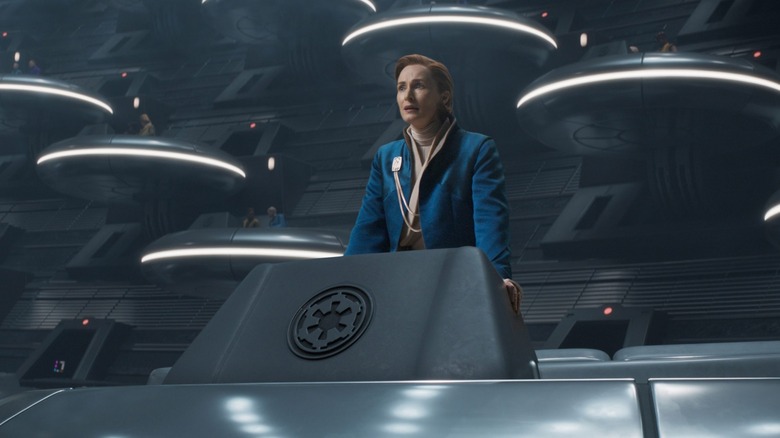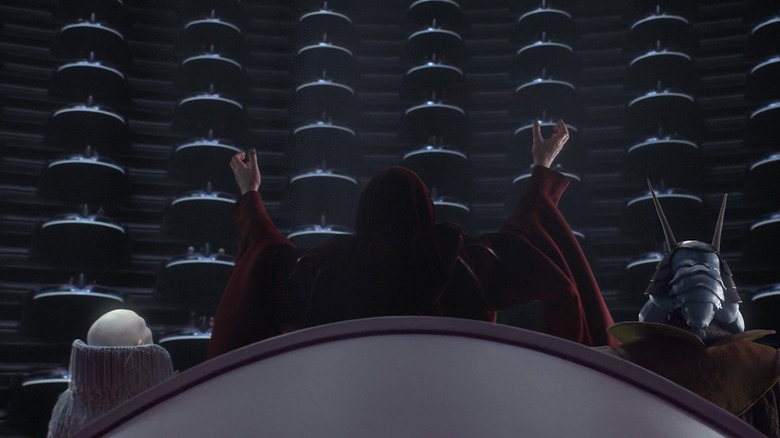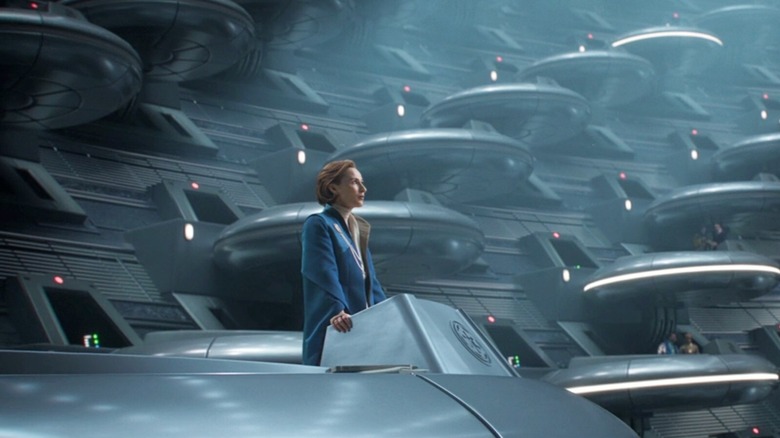Andor Finally Brought Back What Star Wars Was Missing: The Galactic Senate
"Andor" is unlike anything we've seen from "Star Wars" so far, a grounded show with gravitas, emotional impact, thematic resonance, and absolutely gorgeously-shot moments. This is a show where evil is not over-the-top, but mundane, cold, and detached; where heroism isn't just killing a bunch of people or exploding space stations, but also just refusing to look the other way when evil is happening.
Set between the prequels and the original trilogy, "Andor" has the opportunity to explore and expand things we haven't seen the franchise do in live-action before, going deeper into the way people join a rebellion, explaining rebel technology, and more. The newest episode of the show also explores how politics play into a brewing civil war, all while bringing back a location that has been sorely missed in "Star Wars," the Galactic Senate.
That's right, the Galactic Senate. This beautiful building located at the very center of Coruscant, the city that is also a planet, is finally back in all its bureaucratic, cold, baffling glory. To celebrate the return of the senate, here's why that place is so important to "Star Wars," and why having politics in the franchise is very cool, actually.
The first six episodes of "Andor" have sort of been split in focus. On one hand, we have the story of the titular Cassian Andor as he is introduced to the rebellion and starts engaging in the fight against the Empire after being complacent for too long. Meanwhile, we also have the story of Mon Mothma and Luthen Rael, who try to fight against the empire from its core, on the planet-city coruscant.
In defense of politics in Star Wars
You remember Coruscant, right? This was a prominent location in the prequels, the home of the Senate, of the Jedi Temple, and of Dexter Jettster's diner. From the moment we first saw this planet, it was a spectacular sight that is unlike anything else in "Star Wars." This is not a planet with a single landscape dictated by the weather, but a sprawling, massive metropolis with multiple levels and locations each with its own aesthetic, from the seedy, cyberpunk-inspired underground to the geometric uniformity of the political hub of the galaxy.
At the center of it all is the Imperial Senate. This was the place that saw the start of the Battle of Naboo, the place that started the Clone Wars, and the place where the Empire was born. Politics, and therefore the senate, are hugely important to both the prequels and the overall history of "Star Wars." Sadly, all these scenes were (and still are) criticized, and not entirely without reason. After all, the political scenes in the prequels were both long and tonally inconsistent with what had come before.
Yet that is exactly why the senate, and therefore the politics, are so important to the overall franchise. It is the introduction of seedy politicians and of the bureaucracy that turned "Star Wars" from a fun story heavily inspired by "Flash Gordon" and "Buck Rogers" into a complex epic that shares more with "Dune" than just a desert planet. Lucas showed that good guys aren't always good, that bad guys aren't always so easy to spot, and that even regular people can be complicit in the rise of evil.
Senator Mothma has the floor
Though the movies could have done a better job of mixing the politics with the adventure, animated shows like "Clone Wars" showed the importance of politicians in the galactic conflict. We see how Padmé and Bail Organa try to slow down Palpatine and his war ambitions, we see the reason for entire systems to join the Separatists, and the evils of the Republic's bureaucracy, and more.
Now, "Andor" is carrying on that tradition. Thanks to the show's darker and more mature tone, we're seeing the politics play a more central role than in the movies, or at least a more serious role. Backdoor dealings, political schemes, and treaties are an important part of a rebellion, and seeing Mon Mothma keep the fight alive both in the shadows and on the senate floor by trying to bring some humanity to the Empire is fascinating. By bringing back Coruscant as a location, we're seeing the poignant contrast between the obscene wealth of the galactic capital and the rest of the rigid and oppressed galaxy.
"Andor" feels like the live-action "Star Wars" project that can finally fulfill the promise of the prequels, at least when it comes to the significance of galactic politics. With the darker tone of "Andor," we can finally see how wars are fought on multiple fronts, all while continuing to show us one of the coolest places in the galaxy.


